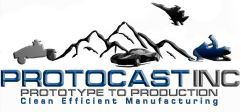Casting prototypes of tools and parts is a complex process that must be done with precision and executed by trained and experienced professionals. At Prototype Casting, our experts take your most complex designs, give advice for design modifications when necessary, and turn your ideas into a reality. There are many ways to cast a part and each method has specific advantages including production speed, wall thickness, complex geometry, and other physical properties. Here, we will compare rubber plaster molding to rapid investment casting processes and their corresponding advantages so you can choose which casting method is best for your needs.

Rubber Plaster Mold Casting vs Rapid Investment Casting
Prototype Casting Inc
Rubber Plaster Molding
- can be used for prototype molds with low production quantities
- best for parts made from aluminum and magnesium
- average production time is 2-5 weeks
- allows for easier design modifications to the part’s geometry if needed
- allows the duplication of appearance and physical features
- used best for production demands of up to 250 units a year or less
Advantages: replicates original tooling surface finish, 0 to 1 degree of draft possible, supports designs with thin walls and complex geometry modifications
Rapid Investment Casting
- can be used in mass production quantities.
- casting best for aluminum, magnesium, zinc, and stainless steel tooling
- average production time in as little as 2 days depending on complexity
- often used for complicated geometries and thin wall sections.
- allows us to quickly produce up to 5,000 units a year
Advantages: production speed, allows for production of intricate and complex geometries, thin wall thickness capabilities varies from
When deciding between which casting method is best for you, consider the advantages of each. Rubber plaster molding is a highly recommended method for producing larger quantities of prototypes that you do not need immediately. Although the production time is much longer compared to rapid investment molding, this silicone tooling can be used to make hundreds of units without degradation. This process is best used for casting electronic closures and lightweight parts from aluminum and magnesium. Alternatively, rapid investment casts do exactly what their name suggests. This method cuts down the production time significantly depending on the intricacy and strength of the casting alloys. Stainless steel allows for walls of .125 inches and magnesium and aluminum at .080 inches. Zinc is a flexible alloy that can be used to create thinner walls but is also denser than other alloys. Choosing the right method for your prototype casting needs depends on your time constraints, design intricacies, and individual needs.
Consult our Team
Our staff will take the time and care to produce prototypes that are precise, functional, and inspected by our engineers. Each casting process is designed to enhance specific features and satisfy your designated timeframes. We have the ability to ensure that your casts are done to your expectations. Our foundry takes your designs and makes them into a reality. We will help you choose the right methods to have your parts and tools cast. Reach out to use today to discover all of our services and send us your designs today!
